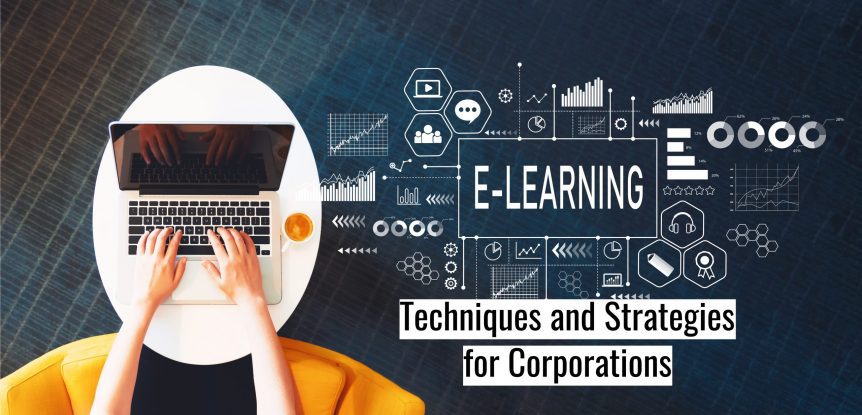8 Effective E-Learning Techniques and Strategies for Corporations
All businesses and organisations face challenges when it comes to training. If you are a corporation, there are additional issues to consider, including the large numbers of people you need to train and the variations that exist between departments. Those variations include everything from motivation to competency levels to ease of deployment.
This is even before you consider geography, with all its cultural, language, regulatory, and legal differences. For example, the training you develop for team members in Dubai would be different from training developed for your teams in Saudi Arabia, which would also be different from the training you provide for teams in Europe.
While these challenges exist, there are e-learning techniques and strategies that you can use to mitigate the impact, delivering better training and business results, and improving return on investment.
-
Empower Learners
You should empower learners and make it possible for them to take more responsibility for their professional development. You can do this by creating personalised e-learning courses where the content delivered depends on tests or learner responses to questions.
Offering your team optional supplementary information and training courses also helps, as do techniques and strategies that enable learners to complete training courses at times that best suit them.
-
Use a Blended Learning Strategy
E-learning is one of the most powerful tools you can use to deliver training in your organisation, but there are several reasons why it won’t be suitable in 100 percent of situations.
Therefore, you should embrace this fact, evolving your overall approach into a blended learning strategy. This is where people on your team learn through e-learning, in the classroom, and through other delivery methods, with many of the courses and modules integrated to create a more joined-up experience.
-
Personalise the Learning Experience
Differences exist in any organisation, but the size of modern corporations scales up those differences significantly. In fact, for most organisations, it is difference that makes them so strong and successful.
However, differences can be a hindrance when it comes to training. For example, how do you implement training on a topic when the people who will complete the training have totally different expectations, ability levels, or day-to-day experiences.
The answer is to personalise your courses. With e-learning, this is easier to do compared to all other forms of training delivery because you can create e-learning courses with a modular design. This means the underlying structure and core content can remain consistent, while individual modules can change to ensure a sufficient level of personalisation.
-
Ensure Your E-Learning Courses Are Mobile Optimised
Making it possible for learners to decide when to complete e-learning courses will improve take-up rates, completion rates, immediate results, long term retention rates, and learner satisfaction.
A key part of achieving this goal is to ensure your e-learning courses are optimised for the mobile devices that members of your team regularly use. Optimising for mobile phones is usually the priority.
-
Use Microlearning
Microlearning is a structured learning strategy where you break your courses into short, bitesize chunks. Each chunk focuses on a single and specific element of the training course and should be as short as possible. How short depends on the course topic and the information being presented, but the time should be measured in minutes, i.e., less than 10 minutes where possible.
Microlearning works as a strategy as our brains are better at processing small amounts of information more often compared to trying to remember everything presented to us in one longer and more complicated session.
-
Add Gamification Elements
Adding gamification to your e-learning courses captures the attention of learners and improves the learning experience. It also helps to engage the learner with the content you are presenting in the course, making it feel less like training – at least, less like formal training.
This delivers better results overall, which is the ultimate objective when creating any training course.
-
Make E-Learning Courses Interactive
You shouldn’t just stop at gamification elements when creating your e-learning courses, as all interactive elements will help. For example, quizzes are an important feature of most e-learning courses, plus scenarios can be a highly effective learning tool. This particularly applies if you use branching scenarios.
-
Mix Up Content Types
With e-learning, you can present information to learners using multiple types of content, including text, images, graphics, graphs, charts, infographics, video, animations, and more. You should make the most of this capability by using the content type that will most effectively explain the information you are presenting.
The Importance of Adaptability
In summary, the e-learning techniques and strategies you can use to enhance training in your large enterprise include:
- Empowering learners
- Using a blended learning strategy
- Personalising the learning experience
- Optimising for mobile devices
- Using microlearning elements
- Adding gamification elements
- Making courses interactive
- Mixing up content types
Even with a quick glance at this list, you can see they won’t all apply to every e-learning course you create. Some will be suitable, some will be highly effective, some will be impossible, and some won’t be worth the time or effort.
This highlights the importance of adaptability when it comes to creating e-learning content. You need to look at each course on its own merits, developing a structure, implementing strategies, and using techniques that will get the best results.
Doing this will raise the overall performance of the training function in your company.
